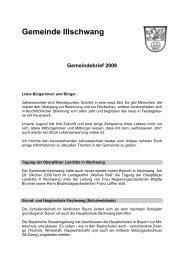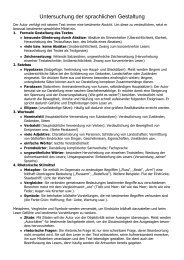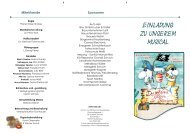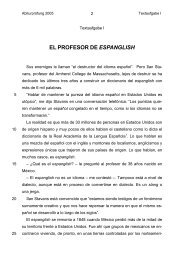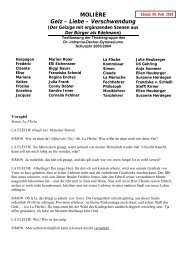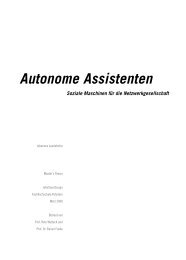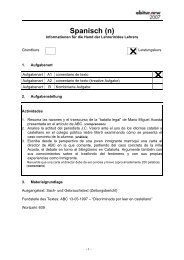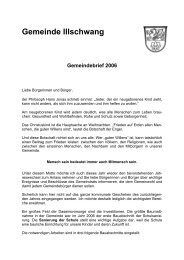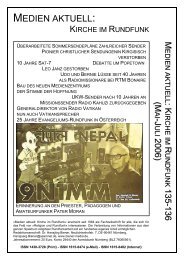Enhanced T cell responsiveness to citrulline-containing ... - Asamnet
Enhanced T cell responsiveness to citrulline-containing ... - Asamnet
Enhanced T cell responsiveness to citrulline-containing ... - Asamnet
You also want an ePaper? Increase the reach of your titles
YUMPU automatically turns print PDFs into web optimized ePapers that Google loves.
224<br />
Multiple Sclerosis<br />
C8 peptide 115 ± 131. Further attempts <strong>to</strong> map the<br />
peptide speci®city <strong>to</strong> individual <strong>citrulline</strong> residues<br />
were not successful.<br />
Discussion<br />
T <strong>cell</strong> response <strong>to</strong> MBP-C8 in MS<br />
LR Tranquill et al<br />
Many potential candidate au<strong>to</strong>antigens, particularly<br />
MBP, PLP and MOG, have been studied for their<br />
relevance in MS and encephali<strong>to</strong>genicity in EAE<br />
models. 1 Assessing biological relevance in humans has<br />
<strong>to</strong> rely on indirect evidence such as increases in T <strong>cell</strong><br />
frequency, higher af®nity for the antigen, memory<br />
phenotype, cy<strong>to</strong>kine pro®le, i.e. secretion of proin¯amma<strong>to</strong>ry<br />
cy<strong>to</strong>kines, and cy<strong>to</strong><strong>to</strong>xicity. The results of the<br />
present study demonstrate that the T <strong>cell</strong> response<br />
against a post-translational modi®cation of MBP, i.e.<br />
MBP-C8, is relatively enhanced in MS patients as<br />
compared with HLA-DR-matched control donors. Due<br />
<strong>to</strong> the limited availability of MBP-C8, a larger cohort of<br />
MS patients could not be studied, and it needs <strong>to</strong> be<br />
stressed that our current results have been obtained with<br />
MS patients with long-standing disease and an overrepresentation<br />
of PP-MS. The increased response in MS<br />
patients is evident in some cases as a higher <strong>to</strong>tal<br />
number of MBP-C8-reactive TCL and, in other cases, as<br />
higher stimulation indices in the reactive lines or both.<br />
In addition, they were tested for reactivity against three<br />
citrullinated peptides of MBP. TCLs derived from<br />
patient MS1 showed a predominant reactivity <strong>to</strong> the Cterminal<br />
MBP-C8 peptide 151 ± 170. We were unable <strong>to</strong><br />
map further the ®ne speci®city in the other two MBP-C8<br />
peptides. Furthermore, our overall limited success with<br />
determining the peptide speci®city may indicate either<br />
that the MBP-C8 isolated from native brain myelin<br />
contains other important post-translational modi®cations<br />
which were not present in the synthetic, <strong>citrulline</strong><strong>containing</strong><br />
peptides, or that the natural proteolytic<br />
cleavage of MBP-C8 in antigen-presenting <strong>cell</strong>s creates<br />
different peptides than the ones chosen for synthesis.<br />
The relatively higher level of MBP-C8 in MS brain 9<br />
could help explain our ®nding of a prominent role for<br />
MBP-C8 as an antigen for T <strong>cell</strong>s in MS. The<br />
continuous or repeated release of MBP-C8 and its de<br />
novo synthesis could lead <strong>to</strong> an in vivo expansion of<br />
MBP-C8-speci®c T <strong>cell</strong>s. The trend for an overall<br />
greater response <strong>to</strong> MBP-C8 in MS patients (with<br />
respect <strong>to</strong> both number of MBP-C8 responsive TCL<br />
and magnitude of their SIs) supports these considerations.<br />
Besides an overall stronger response <strong>to</strong> MBP-C8 in<br />
MS patients, it is also noteworthy that the MBP-C8speci®c<br />
response exceeded that <strong>to</strong> MBP-C1 considerably,<br />
e.g. in patient MS1. Whether this is due <strong>to</strong> a<br />
higher abundance of MBP-C8 in this patient or higher<br />
immunogenicity of MBP-C8 for T <strong>cell</strong>s in this<br />
individual is unresolved. The latter possibility may<br />
be due, in part, <strong>to</strong> the fact that certain native MBP<br />
isoforms are expressed in the thymus where <strong>to</strong>lerance<br />
may be established. 25 It is not known if central, i.e.<br />
thymic, <strong>to</strong>lerance <strong>to</strong> the developmentally more immature<br />
MBP-C8, occurs.<br />
Similar <strong>to</strong> other isoforms of MBP, e.g. the 21.5 kd<br />
MBP in which exon 2 is expressed, MBP-C8 may be<br />
relevant <strong>to</strong> disease pathogenesis not only since its<br />
expression is upregulated during the disease process,<br />
but also due <strong>to</strong> the physicochemical instability of<br />
MBP-C8 compared <strong>to</strong> the more basic MBP charge<br />
isomers. In our previous report, 10 under the condition<br />
of enzymatic degradation, MBP-C8 is degraded much<br />
faster by cathepsin D than MBP-C1 <strong>to</strong> release<br />
immunodominant epi<strong>to</strong>pes which presumably prime<br />
not only MBP-C8-reactive T <strong>cell</strong>s but also MBP-C1responsive<br />
T <strong>cell</strong>s. This was proved by the ®ndings of<br />
the current experiment in which some human T <strong>cell</strong><br />
lines generated with MBP-C8 react with both MBP-C8<br />
and MBP-C1 and <strong>to</strong> our surprise, some even respond<br />
<strong>to</strong> MBP-C1 only. With respect <strong>to</strong> MBP-C1-only reactive<br />
lines, it is most likely that the absence of reactivity <strong>to</strong><br />
MBP-C8 which had been used <strong>to</strong> generate the lines<br />
initially, is due <strong>to</strong> differences in the relative sensitivity<br />
<strong>to</strong>wards the two antigens, i.e. MBP-C1 induces a<br />
heteroclitic response, causing stimulation at lower<br />
antigen doses compared <strong>to</strong> MBP-C8 as previously<br />
reported. 26 In two of three multiplex families studied<br />
there was a signi®cantly increased exon 2 MBPspeci®c<br />
response even though there was no difference<br />
in the frequency of exon 2 MBP-speci®c T-<strong>cell</strong><br />
between the MS group and the healthy control group. 20<br />
The T <strong>cell</strong> response <strong>to</strong> the MBP-C8 isomer is<br />
elevated in MS patients, but clearly also, though in a<br />
smaller scale, present in healthy controls. Future<br />
studies will need <strong>to</strong> address whether increased<br />
expression and immunoreactivity <strong>to</strong> MBP-C8 correlates<br />
with speci®c disease courses and subtypes of MS in<br />
larger groups of patients strati®ed for these criteria. In<br />
addition, cy<strong>to</strong>kine pro®les of the MBP-C8 T <strong>cell</strong> lines<br />
should be examined in the future <strong>to</strong> assess for<br />
differences between the MS patients and the normal<br />
controls. The encephali<strong>to</strong>genicity of MBP-C8, its<br />
structural instability and the results of the present<br />
investigation underscore the prominent role for a<br />
selective charge isomer of MBP. Other size isomers<br />
and post-translational modi®cations of MBP may<br />
deserve more detailed analysis for their roles in the<br />
au<strong>to</strong>immune response <strong>to</strong> MBP.<br />
Acknowledgements<br />
This investigation was supported by the Research<br />
Program of the Veterans Administration. Ms Linda<br />
Brent and Mrs Denise Ball assisted in the preparation<br />
of the manuscript.<br />
References<br />
1 Martin R, McFarland HF. (1995) Immunological aspects<br />
of experimental allergic encephalomyelitis and multiple<br />
sclerosis. Crit Rev Clin Lab Sci 32: 121 ± 182.<br />
2 Campagnoni AT et al. (1993) Structure and developmental<br />
regulation of golli-MBP, a 105-kilobase gene that<br />
encompasses the myelin basic protein gene and is<br />
expressed in <strong>cell</strong>s in the oligodendrocyte lineage in the<br />
brain. JBiolChem268: 4930 ± 4938.



